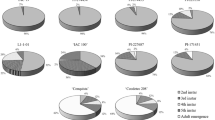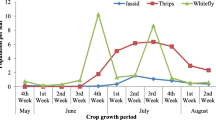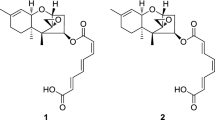Abstract
Asiatic cottons [Gossypium arboreum (L.)] have been investigated as a source of resistance to the tobacco budworm [Heliothis virescens (Fab.)] because their diversely colored petals have been presumed to contain various allelochemicals. However, we found that larvae fedG. arboreum squares (buds) grew about equally compared with those fed squares from commercialG. hirsutum lines. The best source of resistance was found in severalG. hirsutum double-haploid (DH) lines. In our investigation of allelochemicals, G.arboreum lines were found to contain much less gossypol in leaves, squares (buds), and petals thanG. hirsutum L. lines. Flavonoids were significantly higher inG. arboreum lines only in petals. Of 22G. arboreum lines from which squares were gathered and fed to tobacco budworm (TBW) larvae in the laboratory, larval growth was not significantly decreased on any, but larval survival was decreased on six. When the square flavonoids were isolated and incorporated in laboratory diets for the TBW, moderate toxicity was observed. However, the estimated toxicities were not greater than those of the same flavonoid isolates fromG. hirsutum lines. The most prevalent flavonoids, all previously found in G.arboreum plant tissues, were gossypetin 8-0-glucoside and gossypetin 8-0-rhamnoside, neither of which were present inG. hirsutum tissue. Quercetin 3-0-glucoside, quercetin-3′-0-glucoside, and quercetin 7-0-glucoside were also present in significant amounts in both species. Gossypetin 8-0-rhamnoside and gossypetin 8-0-glucoside were the most toxic flavonoids tested (the ED50% was estimated to be 0.007 and 0.024) and therefore may prove to be contributing factors of resistance to TBW feeding.
Similar content being viewed by others
References
Altman, D.W., Stipanovic, R.D., andBell, A.A. 1990. Terpenoids in foliar pigment glands of A, D, and AD genome cottons: Introgression potential for pest resistance.J. Hered. 81:447–454.
Collum, D.H., Hedin, P.A., White, W.H., Parrott, W.L., Jenkins, J.N., andGrimley, E.B. 1981. Studies on the structural properties of cotton tannin and its toxicity to the tobacco budworm. Abstracts of Papers, 182nd National Meeting of the Americal Chemical Society, New York. American Chemical Society, Washington, D.C. Pest Abstract No. 54.
Hedin, P.A., andWaage, S.K. 1986. Roles of flavonoids in plant resistance to insects, pp. 87–100, in V. Cody, E. Middleton, and J. Harborne (eds.). Plant Flavonoids in Biology and Medicine: Biochemical, Pharmacological and Structure-Activity Relationships. Alan R. Liss, New York.
Hedin, P.A., Minyard, J.P., Thompson, A.C., Struck, R.F., andFrye, J. 1967. Constituents of the cotton bud. Identification of the anthocyanin as chrysanthemin.Phytochemistry 6:1165–1167.
Hedin, P.A., Miles, L.R., Thompson, A.C., andMinyard, J.P. 1968. Constituents of the cotton bud. Formulation of a boll weevil feeding stimulant mixture.J. Agric. Food Chem. 16:505–513.
Hedin, P.A., Jenkins, J.N., Collum, D.H., White, W.H., Parrott, W.L., andMacGown, M.W. 1983a. Cyanidin-3\-glucoside, a newly recognized basis for resistance in cotton to the tobacco budworm.Experientia 39:799–801.
Hedin, P.A., Jenkins, J.N., Collum, D.H., White, W.H., andParrott, W.L., 1983b. Multiple factors in cotton contributing to resistance to the tobacco budworm, pp. 349–365, in P.A. Hedin (ed.). Plant Resistance to Pests. ACS Symposium Series 208, American Chemical Society, Washington, D.C.
Hedin, P.A., Parrott, W.L., Jenkins, J.N., Mulrooney, J.E., andMenn, J.J. 1988. Elucidating mechanisms of tobacco budworm resistance to allelochemicals by dietary tests with insecticide synergists.Pest Biochem. Physiol. 32:55–61.
Hedin, P.A., Parrott, W.L., andJenkins, J.N. 1991. The effects of cotton plant allelochemicals and nutrients on the behavior and development of the tobacco budworm.J. Chem. Ecol. 17:1107–1121.
Jenkins, J.N., Parrott, W.L., McCarty, J.C., Jr., andWhite, W.H. 1982. Breeding cotton for resistance to the tobacco budworm: Techniques to achieve uniform field infestation.Crop Sci. 22:400–404.
Mabry, T.J., Markham, K.R., andThomas, M.B. 1970. The Systemic Identification of Flavonoids. Springer-Verlag, New York, pp. 10–13.
Parks, C.R. 1965. Floral pigmentation studies in the genusGossypium. I. Species specific pigmentation patterns.Am. J. Bot. 52:309–316.
Parrott, W.L., Jenkins, J.N., andMcCarty, J.C. 1983. Feeding behavior of first-stage tobacco budworm on three cotton cultivars.Ann. Entomol. Soc. Am. 76:167–170.
Parrott, W.L., Jenkins, J.N., Mulrooney, J.E., McCarty, J.C., andShepherd, R.L. 1989. Relationship between gossypol gland density on cotton squares and resistance to tobacco budworm larvae.J. Econ. Entomol. 82:589–592.
Ramolho, F.S. 1983. Behavior of the tobacco budworm in cotton. PhD dissertation. Mississippi State University, Mississippi State, Mississippi.
Ramolho, F.S., McCarty, J.C., Jenkins, J.N., andParrott, W.L. 1984. Distribution of tobacco budworm (Lepidoptera: Noctuidae) larvae within cotton plants.J. Econ. Entomol. 77:591–594.
SAS Institute. 1985. SAS User's Guide: Statistics, Version 5 Edition, SAS Institute, Inc., Cary, North Carolina, 956 pp.
Stipanovic, R.D., Altman, D.W., Begin, D.L., Greenblatt, G.A., andBenedict, J.H. 1988. Terpenoid aldehydes in upland cottons: Analysis by aniline and HPLC methods.J. Agric. Food Chem. 36:509–515.
Waage, S.K., andHedin, P.A. 1984. Biologically-active flavonoids fromGossypium arboreum. Phytochemistry 23:2509–2511.
Author information
Authors and Affiliations
Additional information
Mention of a trademark, proprietary product, or vendor does not constitute a guarantee or warranty of the product by the U.S. Department of Agriculture and does not imply its approval to the exclusion of other products or vendors that may also be suitable.
Rights and permissions
About this article
Cite this article
Hedin, P.A., Jenkins, J.N. & Parrott, W.L. Evaluation of flavonoids inGossypium arboreum (L.) cottons as potential source of resistance to tobacco budworm. J Chem Ecol 18, 105–114 (1992). https://doi.org/10.1007/BF00993746
Received:
Accepted:
Issue Date:
DOI: https://doi.org/10.1007/BF00993746




